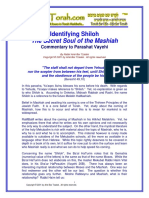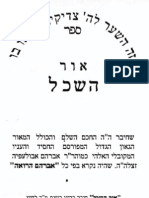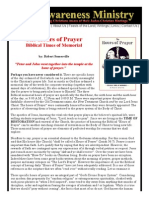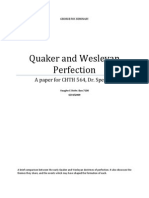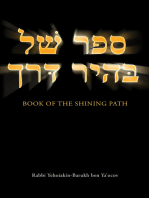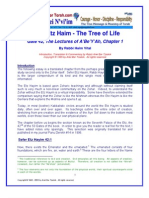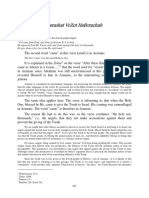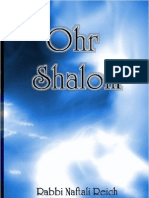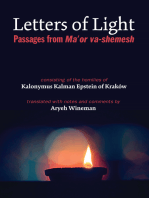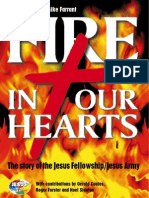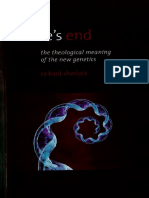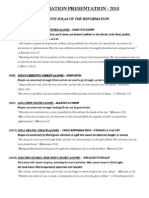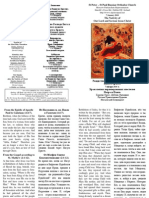The Tikunei Zohar of Rabbi Shimon Bar Yohai: Shiur 1
The Tikunei Zohar of Rabbi Shimon Bar Yohai: Shiur 1
Uploaded by
Alexei Diaz-PazCopyright:
Available Formats
The Tikunei Zohar of Rabbi Shimon Bar Yohai: Shiur 1
The Tikunei Zohar of Rabbi Shimon Bar Yohai: Shiur 1
Uploaded by
Alexei Diaz-PazOriginal Title
Copyright
Available Formats
Share this document
Did you find this document useful?
Is this content inappropriate?
Copyright:
Available Formats
The Tikunei Zohar of Rabbi Shimon Bar Yohai: Shiur 1
The Tikunei Zohar of Rabbi Shimon Bar Yohai: Shiur 1
Uploaded by
Alexei Diaz-PazCopyright:
Available Formats
The Tikunei Zohar
of Rabbi Shimon Bar Yohai
Translated by Rabbi Ariel Bar Tzadok.
Copyright © 2004 by Ariel Bar Tzadok. All rights reserved.
These translations are for our Tikunei Zohar classes aired live on PalTalk
and available in our online store on tape and CD.
This translation is updated on a weekly basis.
Shiur 1
“Rabbi Shimon arose and fled to the wilderness of Lod. He there hid himself in a cave
along with his son Rabbi Eliezer. A miracle occurred. A carob tree and a spring of water
came forth. They ate from those carobs and drank from that water.
Eliyahu, may he be remembered for good, came to them twice everyday and taught
them. No man knew of this
This is called the Tikunei (Rectifications) of the Zohar. These are the seventy faces of
the Torah that were expounded by Rabbi Shimon Bar Yohai on the word Bereshit
according to the secrets of the Torah.
Rabbi Shimon arose and began with these words before the Shekhina. He began and
said: “The enlightened will shine like the brilliance (zohar) of the heavens” (Dan. 12:3)”
The “enlightened,” this refers to Rabbi Shimon and his friends. They were very careful.
When they gathered to make this work, they received permission, as did Eliyahu along
with them, as did all the souls of the yeshivot to descend among them; as did all the
angels who are concealed and [who come by] the path of thought.
Above them all, permission was granted to all the Holy Names, to all the Havayot, and to
all the appellations to reveal to them the concealed secrets, each Name according to its
level.
Permission was also granted to the Ten Sefirot to reveal to them concealed secrets.
Permission of this nature was not given to reveal such things until comes the generation
of Mashiah.”
Copyright © 1993 - 2003 by Ariel Bar Tzadok. All rights reserved.
Shiur 2
As the radiance of the firmament which includes all colors.
(The alternate version: And the enlightened shall shine as the radiance of the firmament
(Dan. 12:3).
This is the concealed and hidden radiance which is Keter.
The lucid radiance in the Heavens, this is Hokhma.
The radiance that casts out sparks and glows like lighting to the eyes, this is Binah.
Radiance that is white like the Moon, this is Gedolah.
Radiance that shines red like Mars, this is Gevurah.
The glowing radiance that includes yellow (lit. green) like the Sun is Tiferet.
Radiance green as Mercury is Netzah.
Radiance that includes black and red is Hod.
The radiance that shines upon every crossing like one who strikes with a hammer and
cast sparks to all sides, this is Yesod.)
Radiance that is hidden and concealed.
Radiance that is lucid like the Heavens.
Radiance that casts sparks and glows like lighting to the eyes.
Radiance that shines white as the Moon.
Radiance that shines red like Mars.
Glowing radiance which includes yellow like the Sun.
Radiance yellow like Mercury.
Radiance that includes white and red.
Radiance that shines to all crossings like one who strikes with a hammer and casts
sparks to all sides.
Thus from this radiance shines forth a number of Neshamot (souls).
They all shine in the Heavens.
These are the Neshamot (souls) of the enlightened who have the mind [power] (sekhel)
to know the secrets of their Master. All of them are inscribed and delineated in the
Kingdom of the Heavens, like the stars that shine in Heaven. This is what it means when
it says, “they will shine like the radiance of the heavens. As the heavens radiate within
them so the souls of the enlightened like the stars of Heaven radiate within the Throne.
They all fly about in the Heavens. This is the Righteous One, Life of the Worlds, from
who fly forth the Neshamot (souls) of the Righteous and who shine upon the Moon.
Regarding them is it written, “And G-d placed them in the firmament of the Heavens to
shine upon the Earth” (Gen. 1:17).
Copyright © 1993 - 2003 by Ariel Bar Tzadok. All rights reserved.
This Firmament is above the Hayot [angels]. Regarding this it is written, “And above the
Firmament that is over their heads” (Ezek. 1:26). Switch around [the letters of the word]
Rakia (Firmament) and we find [the word] Ikar (essence, or principle) and the foundation
of the Supernal Merkava upon which stand the Hayot and the Throne of the Merkava.
Regarding this does it say, “the Righteous is the foundation of the world” (Prov. 10:25).
This is a reference to the Righteous One above who sustains the concealed world and to
the Righteous One below who sustains the revealed world.
Shiur 3
These are those who (Matzdikei HaRabbim) support the public by the righteous ones
who support the world. What is the Rabbim (public)? These are those of whom it is
said, the Halakha follows the Rabbim (majority). These emanate from the Side of the
Fathers, for there is no Rabbim less than three. The Halakha follows the Rabbim, this is
the Shekhina.
And from here, “And your people are all righteous, they will forever inheret the land.”
(Isaiah 60:21). Regarding which it is said, “the Land is the footstool for My Feet.” (Isaiah
66:1). This is the Shekhina and She includes within Her ten sefirot.
From here Israel are called: (1-malkhut) Kings, (2-yesod) Righteous Ones, (3-hod)
Seers, (4-netzah) Prophets, (5-tiferet) Masters of Torah, (6-gevurah) Mighty Ones, (7-
hesed) Pious Ones, (8-binah) Perceptive Ones, (9-hokhma) Wise Ones, and (10-keter)
Heads of the Thousands of Israel.
Permission was granted to these Neshamot souls who were cast out of their place
following after the Holy One, blessed be He and His Shekhina to nestle into this writing
(of the Zohar), of which it is written, “like a bird that flutters back and forth from its nest,
so does a man go forth and back to his place.” (Proverbs 27:8).
There is no “bird” other than the Shekhina, for She is cast out of Her place. Of this it is
written, “you shall certainly (literally: send, you shall send) send forth the mother, but the
offspring you may take for yourself.” (Devarim 22:7). The [additional] participle ET (prior
to the word) for mother comes to include the lower Shekhina. The mother is the upper
Shekhina.
Of this it is written, “Because of your sins is your mother sent away.” (Isaiah 50:1). Both
of them are cast out from their place. Therefore does the above verse say, “send, you
shall send” two sendings are mentioned; one from the First Temple, and one from the
Second Temple.
Copyright © 1993 - 2003 by Ariel Bar Tzadok. All rights reserved.
This happened to fulfill, “I am HaShem, this is My Name, and My Glory I shall not give to
another.” (Isaiah 42:8). The upper Shekhina. And my praise to the Images, the lower
Shekhina. Thus is a man who goes forth from his place. This is the Holy One, blessed
be He, of Whom it is said, “HaShem is a man of war, for He is cast out after them.
And more . . .Thus is a man who goes forth from his place. Who is this? This is Moshe,
of whom it is written, “and the man Moshe was evry humble.” (Numbers 12:3). For his
spirit went forth after them.
And more . . .Thus is a man who goes forth from his place. This is the righteous man
who goes forth from his place to wander about with the Shekhina (or as the Shekhina), of
whom it is written, “and the dove found no place to rest.”
For thus stood the Sages at the time of the destruction of the Holy Temple. It was
ordained that the houses of the righteous be destroyed. Each one went forth from his
place. Suffice it for a servant to be like his master.
The secret of the matter is this, “he wanders about for food, where is it?” (Job 15:23).
Where is it? (Ayeh?) that He took compassion on him. Even here, “there is none to
guide her.” (Isaiah 51:18). And because of this suffice it for the servant to be like his
master.
There is no bread other than Torah. This is what caused the masters of Torah to be cast
out.
Shiur 4 (2a)
How worthy are the masters of the yeshiva, the masters of Midrash, the masters of
Torah [for they are like] “the bird who has also found a house” (Psalm 84:4). [This is] the
house in which is heard the words of Torah. For in the place wherein which there is
Torah, which itself is the Center Column, the “bird” will also find its home there. Because
of this our Sages have established that any house in which the words of Torah are not
heard in the end will be destroyed. And those in which the words of Torah are heard are
called “eggs,” “chicks,” and “children.” The “eggs” are the masters of the Bible. The
“chicks” are the masters of the Mishna. The “young” are the masters of the Kabbalah.
About them does it say, “the mother is nesting upon the chicks or upon the eggs” (Dev.
22:6). “You shall surely send away” (Dev. 22:7) from them [specifically]. However, with
regards to the masters of Kabbalah it is said, “do not take the mother along with the
young” (Dev. 22:6). For [the others] do not have the mind to perceive the Shekhina as
do the masters of Kabbalah. [Only they] (i.e., the masters of Kabbalah) make for Her a
dwelling [as well as for] the Holy One, blessed be He and fly with them. To every place
4
Copyright © 1993 - 2003 by Ariel Bar Tzadok. All rights reserved.
that She flies they all move with Her as She sends them. However, the “chicks” do not
have complete wings with which to fly, these are the positive commandments; all the
more so the “eggs”. Therefore with regards to them it is said, “you shall surely send
away the mother.”
While he was still saying these things, an elder happened upon him and said, “now it is
written, “and the young you shall take for yourself.” The elder said to him, “every time
[the word] “Et” [is written in the Torah] it comes to add [something]. Therefore the pasuk
does not say “the young you shall take for yourself” (ha’banim Tikah Lakh), rather it says,
“V’et . . . (ha’banim). We have established that this comes to include (add) the chicks.
But it does not say, “the young take for yourself. He said to him, blessed are you, holy
light, for this is certainly how it is. For these “young” are certainly under the Supernal
Mother: pious ones (hasidim), mighty ones, (giborim), masters of Torah, seers, prophets,
righteous ones.
Pious ones (Hasidim) come from the side of Hesed, the level of Avraham. We have
established that there is no mercy (hesed) other than the one who shows mercy to his
Master, and makes for Him a “nest” for His dwelling. This is the Shekhina, She is His
“nest”, His house, His palace, His place of residence. And in the Holy Land is [the place]
of His unity and His home. There is no dwelling or residence other that what an
individual will prepare. Because of this was the attribute of mercy given to Avraham.
Mighty ones (giborim) from the side of Gevurah. They give support to their Lord, to
submit the servant to his Master and the maid servant under her mistress by the knot of
the Tefillin. For one who does not have on Tefillin when reciting the [morning] Shema,
from his side will the servant and maid servant rule over the world. At that same hour
will the Shekhina be angered. Of this is it written, “because of a slave that reigns . . . and
a maid servant who inherits the place of her mistress” (Prov. 30:22).
Even so, She is even more aroused to anger by “the disgusting one when he is sated
with bread” (Prov. 30:22), of whom it is written, “come and partake of my bread” (Prov.
9:5). This one is cheap, and a scoundrel with his money. His name is scoundrel
(disgusting), he is not a provider. He is not of the seed of the fathers of whom it is said,
“the givers of the peoples gathered” (Psalm 47:10). For he is cheap and poor in [true]
knowledge. He does not do good to the masters of Torah by strengthening their hands.
Torah without mitzvot is not the Torah of HaShem.
Masters of Torah are from the Center Column. Herein at midnight did David rise to bond
with the Shekhina who is called Night. He is the “watchman, who calls what of the
night?” (Isaiah 21:11). This is the night of HaShem. This is the protected night of
HaShem. Because of Her it is said all who study Torah by night, the Holy One extends
Copyright © 1993 - 2003 by Ariel Bar Tzadok. All rights reserved.
upon him a line of mercy by day, as it is written, “in the day HaShem will command His
mercy and at night His song is with me.” (Psalm 42:90).
Seers and prophets are from the side of Netzah and Hod. Within them are included the
two Names Havaya-Adnoot, in which there are eight letters, corresponding to the eight
books of the prophets. Prophets are two who are ten, corresponding to the ten sefirot.
Corresponding to them did Ezekiel see ten visions.
Righteous ones (Tzadikim) come from the side of The Righteous One (Tzadik). Of all
these it is said, “do not take the mother from the young” (Dev. 22:6).
And more, these are they who study Torah for the proper reasons (lishmah) and who
observe Her mitzvot which are 613 [in number] and hang from the Name Yod Kay Vav
Kay as grapes hang from the cluster so that they can unite the Name Yod Kay Vav Kay
with the Shekhina as a man unites with his wife with all his organs in order to release
good seed. Of them it is said, “do not take the mother from the young.” However, those
who do not study Torah for the proper reasons (lishmah), of them it is said, “you shall
surely send forth the mother.” [The participle] “ET” is written to include that the Name
Yod Kay Vav Kay and the Shekhina depart from such a person.
Shiur 5 (2b)
And more, those who honor the Shabat and Holidays; it is said about them, “do not take
the mother from the young” (Dev. 22:6). For they perform the work of the children with
the Shabat Queen and with the Holy One, blessed be He, for He is the Shabat day. One
who upholds it and honors it by not following in one’s own way (ref. Isaiah 58:13), this is
the one who honors his father and his mother (ref. Exodus 20:12).
Three worlds there are. Two are inherited by honoring the father and mother and the
third is inherited by Torah [study] that includes within it the children of Yod Kay. Of this it
is written, “For this is your life and the length of your days,” (Deut. 30:20). “It is your life
in this world,” [this is a reference] to the Lower Garden. “And the length of your days,”
refers to the World to Come, the “Long” World.” “Upon the Land that HaShem your G-d
gives you,” (Exodus 20:12) is a reference to [this] physical world.
And more, those who bond the Shekhina with the Holy One, blessed be He with the knot
of the Tefillin. Of them it is said, “Do not take the mother from the young” (Dev. 22:6).
And [of] those who do not bind them as one it says of them, “you shall surely send away
the mother.” (Dev. 22:7). And more, those who unite them together as one, the Center
Column and the Lower Shekhina by reciting the Kriyat Shema of them does it say, “Do
not take the mother from the young.” And [of] those who do not unite them in the unity
of the Kriyat Shema, it is written, “you shall surely send away the mother.” In every place
6
Copyright © 1993 - 2003 by Ariel Bar Tzadok. All rights reserved.
the [Hebrew participle] ET comes to add something. Here it comes to add [a reference]
to the Supernal Wisdom, the Father of faith, which is Binah. Of Her, it is said, (in every
place), “do not take the mother, you shall surely send forth the mother.” Of this it is
written, “For to understanding shall you call,” (Proverbs 2:3). This is the Torah Above, of
which it is said, “do not forsake the teaching of your mother,” (Proverbs 1:8).
And more, those who safeguard the sign of the covenant in its boundary, which is the
eight day, and who observe the sign of the Shabat in its boundary, which are [the letters]
Yod, Yod from Havaya-Adnoot for because of them do the Masters of Mishna have a
standing. So that we do not find a man less than these two it is written, “Do not take the
mother from the young.” And of those who is not found with them everyday these two
signs, which are the sign of the Tefillin and the sign of the brit milah, and on Shabat, the
sign of the brit and the sign of the Shabat it is written of them, “you shall surely send
away the mother.”
And if you are to say why are both needed in every Jew every day, [the answer is] so
that we will not find the Shekhina who is the Yod of Adnoot alone without the Holy One,
blessed be He who is the Yod of Havaya. A man needs that there not be found by him
less than these two, for if so, of him is it said, “a complainer estranges a ruler,” (Proverbs
16:28), for [such a one] estranges the Ruler of the Universe from the Shekhina. [Of] the
feminine it is said [regarding] Her, “it (literally “She” referring to the Shabat) is a sign
forever.” (Exodus 31:17). The male [is] the “eternal covenant of salt” (ref. Numbers
18:19). Because of this the sign of the Tefillin is feminine and the sign of the brit is
masculine. The secret of the matter is MI Ya’aleH LanU HaShamaymaH (who will go up
for us to Heaven) (Dev. 30:12). The initial letters (Reshei Tevot) of this spell out MILAH
and the final letters (Sofei Tevot) spell out Havaya. [With regards] to the feminine Tefillin
it is written, “And it shall be a sign upon your hand” (Ex. 13:16), upon the weak (literally,
dark) hand.
Of this birds nest is it said, it is said, “and there shall be a succah for shade by day,”
(Isaiah 4:6). This is a reference to the Skakh with which Imma uses to cover her
children, her chicks, three myrtles, and two aravot and a lulav. The eggs are the etrogs,
each one having the measure of an egg. Of these that are marked [it is said], “do not
take the mother from the young.” For the three hadasim are a hint to the three fathers,
the two aravot to the two prophets of truth, the lulav to the Tzadik “who flourishes like the
date palm,” (ref. Psalm 92:13). The etrog refers to the Shekhina. The succah refers to
Imma who shades over hem. These [together add up to] eight, corresponding to
Havaya-Adnoot, which is the numerical value of [the word] s-u-c-c-a-h. KU (Kaf
Vav=26), HAS (Hey Samekh=65). Those who do not wave these signs in their hands
[during succot as required by halakha] of them it says, “You shall surely send.” Keter,
Hokhma, for these will not reside with the other eight to make all ten sefirot with each
and every wave of the lulav and its species, with each and every mitzvah.
7
Copyright © 1993 - 2003 by Ariel Bar Tzadok. All rights reserved.
You might also like
- Tikkun HaKlali With Interlinear Hebrew Transliteration and English TranslationDocument12 pagesTikkun HaKlali With Interlinear Hebrew Transliteration and English TranslationIzzy Levy80% (5)
- Tikkun Atzot Nusa Ha Ari aBaD PDFDocument12 pagesTikkun Atzot Nusa Ha Ari aBaD PDFNicolas Finkelstein75% (4)
- 01 Five Levels of SoulDocument18 pages01 Five Levels of Soulscitecinc100% (3)
- Jaim Vital - Shaar HakdamotDocument42 pagesJaim Vital - Shaar Hakdamotclausuber100% (1)
- Parshas Tazria Metzora-EnglishDocument27 pagesParshas Tazria Metzora-EnglishHarav Michael Elkohen100% (1)
- 43 Arizal Parsha Devarim PDFDocument11 pages43 Arizal Parsha Devarim PDFSebastianPalenNo ratings yet
- The Book of Mystry of GodDocument3 pagesThe Book of Mystry of GodEmeka50% (2)
- Commentaries On The Doctrine of TzimtzumDocument20 pagesCommentaries On The Doctrine of TzimtzumRaphael888100% (1)
- The Secret Soul of The Mashiah: Identifying ShilohDocument5 pagesThe Secret Soul of The Mashiah: Identifying ShilohAnonymous 4gJukS9S0QNo ratings yet
- Zohar - Sifra Detzniyutha - Book of SecretsDocument26 pagesZohar - Sifra Detzniyutha - Book of SecretsVictoria Generao0% (1)
- Abraham Abulafia Light of The IntellectDocument63 pagesAbraham Abulafia Light of The Intellectsimontomasi100% (3)
- Spirit Life Training Timothy JorgensenDocument3 pagesSpirit Life Training Timothy Jorgensenvivesur50% (4)
- Flash LibraryDocument53 pagesFlash Librarybulltwister100% (1)
- Biblical Hours of Prayer - Judeo-Christian - Robert SomervilleDocument5 pagesBiblical Hours of Prayer - Judeo-Christian - Robert SomervilleKenneth OkoyeNo ratings yet
- Wesleyan and Quaker PerfectionismDocument12 pagesWesleyan and Quaker Perfectionismbbishop2059No ratings yet
- Maamor - Issa Bemedrash - Chayei Soroh - 5748-1Document28 pagesMaamor - Issa Bemedrash - Chayei Soroh - 5748-1leahNo ratings yet
- From the Guardian's Vineyard on Sefer B'Reshith : (The Book of Genesis)From EverandFrom the Guardian's Vineyard on Sefer B'Reshith : (The Book of Genesis)No ratings yet
- Speaking Torah Vol 2: Spiritual Teachings from around the Maggid's TableFrom EverandSpeaking Torah Vol 2: Spiritual Teachings from around the Maggid's TableNo ratings yet
- Secret of Brit BookDocument33 pagesSecret of Brit BookDavid Saportas Lièvano100% (1)
- Sefer Etz Haim - The Tree of Life: Gate 42, The Lectures of A'Be'Y'Ah, Chapter 1Document7 pagesSefer Etz Haim - The Tree of Life: Gate 42, The Lectures of A'Be'Y'Ah, Chapter 1Yehuda GuzziNo ratings yet
- Patah EnglishDocument32 pagesPatah EnglishJesse GlaserNo ratings yet
- Tzedakah BookDocument82 pagesTzedakah BookcmvrNo ratings yet
- Tikun Book PDFDocument50 pagesTikun Book PDFDavid Saportas50% (2)
- Plagues and The SephirotDocument55 pagesPlagues and The SephirotRBlake7No ratings yet
- Keter D'AtzilutDocument4 pagesKeter D'AtzilutandrijaandrijaNo ratings yet
- Hand Out Anabekoach 20181107 EngDocument1 pageHand Out Anabekoach 20181107 EngSean DickersonNo ratings yet
- 05 Arizal Parshas Chayei SarahDocument24 pages05 Arizal Parshas Chayei SarahAdrian SaavedraNo ratings yet
- Mishkan Hashalom, Tabernacle of PeaceDocument36 pagesMishkan Hashalom, Tabernacle of PeaceAlan García-Ramos100% (1)
- All Torah Light Spreads... Chaim Vital PDFDocument3 pagesAll Torah Light Spreads... Chaim Vital PDFDaville BulmerNo ratings yet
- R Abraham Abulafias Sefer Ha Ot PreliminDocument34 pagesR Abraham Abulafias Sefer Ha Ot PreliminMatveev PlayBoy100% (2)
- Zohar Idra Rabba, Jewish MysticismDocument14 pagesZohar Idra Rabba, Jewish MysticismguacamoledipNo ratings yet
- Sefer ShinuyimDocument475 pagesSefer ShinuyimDavid Saportas Lièvano100% (6)
- Ana BeKoachDocument7 pagesAna BeKoachJuan Gutierrez100% (5)
- Wings of The SunDocument511 pagesWings of The Sunpatobotero043No ratings yet
- Sefer Hochma YadDocument204 pagesSefer Hochma YadDavid Saportas Lièvano75% (4)
- 227 Eng T Bs Sefer Beit Shaar KavanotDocument145 pages227 Eng T Bs Sefer Beit Shaar KavanotJavier Romero GonzalezNo ratings yet
- Five Stages Historical Development KabbalahDocument14 pagesFive Stages Historical Development KabbalahWangshosan100% (1)
- 53 Arizal Parsha VeZot Haberachah PDFDocument13 pages53 Arizal Parsha VeZot Haberachah PDFCesar Dos Anjos100% (1)
- Importance Study ZoharDocument51 pagesImportance Study Zoharvaluecare1542No ratings yet
- Lurianic KabbalahDocument73 pagesLurianic KabbalahChrystianRevelles100% (2)
- Sodot HagilgulimDocument12 pagesSodot HagilgulimJuan MedelNo ratings yet
- Parshas Mishpatim-EnglishDocument25 pagesParshas Mishpatim-EnglishHarav Michael ElkohenNo ratings yet
- Ohr ShalomDocument436 pagesOhr Shalomapi-3811809100% (6)
- SephirotDocument13 pagesSephirotnieotyagiNo ratings yet
- Notes On Editions of Sefer Yetzirah in EnglishDocument27 pagesNotes On Editions of Sefer Yetzirah in EnglishFranck Peterson StuartNo ratings yet
- Zohar - Idra Rabba Qadusha - Greater AssemblyDocument16 pagesZohar - Idra Rabba Qadusha - Greater AssemblyVictoria GeneraoNo ratings yet
- Rabbi Yehudah Lev AshlagDocument46 pagesRabbi Yehudah Lev AshlagJavier Romero Gonzalez100% (1)
- English Siporay Masiyos New PDFDocument512 pagesEnglish Siporay Masiyos New PDFhaggen90tckhotmail.com100% (1)
- Chessed LavrahamDocument76 pagesChessed LavrahamMacielkarug100% (2)
- 01 Arizal Parshas BereishitDocument20 pages01 Arizal Parshas BereishitSebastianPalen100% (1)
- Ana B'Khoach and The Forty-Two Letter Name of God in Rabbinic and Mystical ThoughtDocument9 pagesAna B'Khoach and The Forty-Two Letter Name of God in Rabbinic and Mystical Thoughtmjoymatt100% (2)
- Kosher Kabbalah - Halachic Excerpts From ZoharDocument99 pagesKosher Kabbalah - Halachic Excerpts From ZoharNícolas Gavriel BággioNo ratings yet
- Trees of Life From The Book of Sefer YetzirahDocument15 pagesTrees of Life From The Book of Sefer YetzirahJorge Hegel100% (1)
- Ladder of JacobDocument18 pagesLadder of JacobjosephaufieroNo ratings yet
- Parshas Vayeira English2013Document24 pagesParshas Vayeira English2013Harav Michael Elkohen100% (1)
- 08 Arizal Parshas VaYishlachDocument34 pages08 Arizal Parshas VaYishlachAdrian SaavedraNo ratings yet
- Parshas Chayei SoraDocument27 pagesParshas Chayei SoraHarav Michael ElkohenNo ratings yet
- Seekers of the Face: Secrets of the Idra Rabba (The Great Assembly) of the ZoharFrom EverandSeekers of the Face: Secrets of the Idra Rabba (The Great Assembly) of the ZoharNo ratings yet
- Poli QuamtoDocument72 pagesPoli QuamtoArs Moriendi100% (1)
- Thomas NOONAN - 1977 Pre-970 Dirham Hoards From Latvia e EsthoniaDocument23 pagesThomas NOONAN - 1977 Pre-970 Dirham Hoards From Latvia e EsthoniaAndré Szczawlinska Muceniecks100% (1)
- Temple ArchitectureDocument17 pagesTemple ArchitectureSanjana GopalakrishnanNo ratings yet
- 12-Year-Old Jesus in The Temple: Description Image My NotesDocument5 pages12-Year-Old Jesus in The Temple: Description Image My NotesMaw BerryNo ratings yet
- Roger Forster Fire in Our HeartsDocument435 pagesRoger Forster Fire in Our HeartschariskairosNo ratings yet
- 1 4913727205516771467Document68 pages1 4913727205516771467Benn Basil67% (3)
- Day Iii: 19th February 2006Document4 pagesDay Iii: 19th February 2006&uriNo ratings yet
- Make Her Chase You PDFDocument74 pagesMake Her Chase You PDFanon_89458108550% (2)
- Approaching God Through PrayerDocument3 pagesApproaching God Through PrayerRaymond MortelNo ratings yet
- Nature's EndDocument76 pagesNature's EndPadre Luciano Couto, ccnNo ratings yet
- 40 Durood With Meaning TransliterationDocument49 pages40 Durood With Meaning TransliterationMuhammad Suffyan Eddie67% (3)
- Means of Grace As Formative Holiness - The Role and Significance oDocument182 pagesMeans of Grace As Formative Holiness - The Role and Significance oFernando DiasNo ratings yet
- Rebecca Comay Resistance and RepetitionDocument31 pagesRebecca Comay Resistance and RepetitionEduardoNo ratings yet
- Nataraja PDFDocument36 pagesNataraja PDFtwerry123No ratings yet
- Art and Reform in The Late Renaissance: After TrentDocument12 pagesArt and Reform in The Late Renaissance: After TrentJasmina S. Ciric100% (1)
- Abhinavagupta by Deshpande PDFDocument182 pagesAbhinavagupta by Deshpande PDFMihai BolinteanuNo ratings yet
- Real Gift of ChristmasDocument1 pageReal Gift of ChristmasBamidele OjoNo ratings yet
- For My GoodDocument3 pagesFor My GoodmarceloccelinoNo ratings yet
- Ummul Momnieen: Must Share With Friends IER MTE 2011-13Document3 pagesUmmul Momnieen: Must Share With Friends IER MTE 2011-13Qadeer AliNo ratings yet
- Validasi Data MRDocument335 pagesValidasi Data MRserniNo ratings yet
- Data Laporan Harian Peserta Mudik 2024Document3,396 pagesData Laporan Harian Peserta Mudik 2024hrd.perkasa17No ratings yet
- FR Barrons Recommended BooksDocument9 pagesFR Barrons Recommended BooksTon Rivera88% (8)
- Indian Traditional MotifsDocument5 pagesIndian Traditional MotifsimogenNo ratings yet
- Mauryan Period Part 2 71Document27 pagesMauryan Period Part 2 71nehaNo ratings yet
- 5 Solas of The ReformationDocument2 pages5 Solas of The ReformationKimberly HopkinsNo ratings yet
- The Nativity of Our Lord and Saviour Jesus ChristDocument2 pagesThe Nativity of Our Lord and Saviour Jesus ChristNikolay EvseevNo ratings yet








